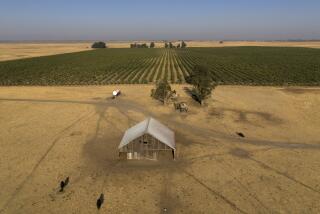County Commission’s Figures Don’t Add Up to Calabasas Cityhood
An economic study predicting that cityhood would be a financial disaster for Calabasas appears to have doomed plans for an incorporation election this year in the 26-square-mile community at the western edge of the San Fernando Valley.
The 24,558 residents of Calabasas would have to spend more than twice as much as they would receive in tax revenues during their city’s first year of existence, according to a fiscal analysis prepared this week for the Los Angeles County Local Agency Formation Commission.
Because of that, the commission should reject an incorporation application scheduled for review on May 13, concluded the commission’s executive officer, Ruth Benell. Her recommendations are almost always accepted by the commission.
‘Insufficient Revenue’
“There appears to be insufficient revenue to support the needed services being provided to the area,” Benell said. “It is the recommendation of the staff that this proposal be denied.”
Benell said state and county agencies estimate that revenues for the proposed city from such sources as motor-vehicle, property and gas taxes would total $2.8 million. But county departments estimate that the city would spend $5.7 million its first year on such things as police and fire protection and other services now provided by the county.
The proposed City of Calabasas would extend from the Los Angeles city limit at Woodland Hills westward to Agoura Hills, and the Ventura County line on the north to the Saddle Peak area in the Santa Monica Mountains on the south.
Benell’s report was a setback for incorporation backers, who have worked for two years to create the city and collected 2,239 signatures on a petition supporting a cityhood election Nov. 3.
They said Thursday that they will meet next Wednesday to discuss their options. Short of quickly finding a major mistake in
enell’s figures, those options seem limited, conceded committee members, who did not want to be quoted by name.
Although sales-tax revenues from newly opened Calabasas businesses--including as two automobile dealerships--were not counted by Benell, it is unlikely that the committee will be able to persuade the Local Agency Formation Commission to increase its estimate of revenue totals, one committee member said.
If the committee tries to redraw its boundaries and shrink the proposed city to cut expenses, such as the projected $1.8-million cost of sheriff’s patrols, it will have to amend or refile its application.
Either move likely would cause the group to miss the Aug. 7 deadline to win support of the commission and county supervisors that is necessary to qualify the issue for the November ballot, another committee member said.
Meeting Deadline
“It would probably take us three months to get through the required hearings, and longer than that if we didn’t have something pretty pure to begin with,” said the committee member. “We might not have made it this year anyway.”
Robert Hill, president of the cityhood committee, said the group plans to closely study Benell’s figures before its crucial meeting next week. He said the expenditures seem “extraordinarily high.”
“I don’t think this is the end,” he said. “I think we’re determined be a city--if not this year, then next.”
Hill said Calabasas’ problems might turn out to be less vexing than those that have recently confronted cityhood backers in the Santa Clarita Valley.
Boosters of the proposed City of Santa Clarita, in the Newhall area, cut their proposed city territory in half to turn a projected $4-million city deficit into an anticipated $3.6-million surplus, although the process took two months to complete. The formation commission approved the revised Santa Clarita Valley petition on Wednesday.
Likely to feel the knife if Calabasas is cut back are the rural neighborhoods of Monte Nido and Cold Creek, five miles south of the Ventura Freeway, near the center of the Santa Monica Mountains.
Cityhood planners said they included those sparsely inhabited areas because of their longstanding identification with Calabasas, despite warnings that surrounding brushland would significantly increase the cost of fighting wildfires.
Fire-Protection Costs
Benell’s analysis suggests that it would cost Calabasas $1.6 million to pay the county for fire protection for the proposed city.
Similar fire protection costs were blamed in 1981 for scuttling the Calabasas area’s previous incorporation attempt. That was a proposed 30,000-resident City of Rancho Las Virgenes between Westlake Village and Woodland Hills.
Smaller independent cities were subsequently created in Westlake Village and Agoura Hills.
It was a 1983 Agoura Hills annexation drive that sparked formation of the current Calabasas cityhood campaign. Residents of a 400-home neighborhood on the west side of Calabasas reacted by opposing the annexation, which was being promoted by the Las Virgenes Homeowners Federation, a coalition of homeowner groups.
Cityhood boosters said their campaign also could block any attempt by the City of Los Angeles to extend its city limits from Woodland Hills westward into affluent Calabasas Park.
More to Read
Sign up for Essential California
The most important California stories and recommendations in your inbox every morning.
You may occasionally receive promotional content from the Los Angeles Times.










